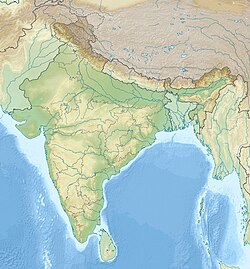|
Chanderi
Chanderi, is a town of historical importance in Ashoknagar District of the state Madhya Pradesh in India. It is situated at a distance of 127 km from Shivpuri, 37 km from Lalitpur, 55 km from Ashok Nagar and about 46 km from Isagarh. It is surrounded by hills southwest of the Betwa River. Chanderi is surrounded by hills, lakes and forests and is spotted with several monuments of the Bundela Rajputs. It is famous for ancient Jain Temples. Its population in 2011 was 33,081. HistoryChanderi is mentioned by the Persian scholar Alberuni in 1030. Ghiyas ud din Balban captured the city in 1251 for Nasiruddin Mahmud, Sultan of Delhi. Sultan Mahmud I Khilji of Malwa captured the city in 1438 after a siege of several months. Rana Sanga of Mewar conquer much of the Malwa along with Chanderi and appointed his vassal Medini Rai a rebellious minister of Sultan Mahmud II of Malwa as ruler of Malwa under his lordship. Medini Rai made Chanderi as capital of his kingdom.[2] In the Battle of Chanderi, the Mughal Emperor Babur captured the fort from Medini Rai and witnessed the macabre Rajput rite of jauhar, in which, faced with certain defeat and in an attempt to escape dishonor in the hands of the enemy, women with children in their arms jumped in a fire pit to commit suicide, which was made for this specific purpose, against the background of vedic hymns recited by the priests. Jauhar was performed during the night and in the morning the men would rub the ashes of their dead women folk on their forehead, don a saffron garment known as kesariya, chew tulsi leaves (in India tulsi leaves are placed in the mouth of a dead body), symbolizing their awareness about impending death and resolve to fight and die with honour. This method of fighting & dying for the cause of retaining honour was called saka.[3] In 1529, Puran Mal defeated Babur's forces and captured Chanderi.[4][need quotation to verify] In 1542 it was captured by Sher Shah Suri and added to the governorship of Shujaat Khan. The Mughal Emperor Akbar made the city a sarkar in the subah of Malwa.[citation needed] The Bundela Rajputs captured the city in 1586, and it was held by Ram Sab, a son of Raja Madhukar of Orchha. In 1646 Devi Singh Bundela was made ruler of the city, and Chanderi remained in the hands of his family until it was annexed in 1811 by Jean Baptiste Filose for the Maratha ruler Daulat Rao Sindhia of Gwalior. The city was transferred to the British in 1844. The British lost control of the city during the Revolt of 1857, and the city was recaptured by Hugh Rose on 14 March 1858. Richard Harte Keatinge led the assault, for which he was awarded the Victoria Cross. The city was transferred back to the Sindhias of Gwalior in 1861, and became part of Isagarh District of Gwalior state. After India's independence in 1947, Gwalior became the capital of the new state of Madhya Bharat, which was merged into Madhya Pradesh on 1 November 1956. GeographyChanderi is located at 24°43′N 78°08′E / 24.72°N 78.13°E.[5] It has an average elevation of 456 metres (1496 feet). DemographicsAs of 2001[update] India census,[6] Chanderi had a population of 28,313. Males constitute 52% of the population and females 48%. AccessThere is a good roadway network in Chanderi. The town lies at State Highway 20 and National Highway 376 with connections to Ashoknagar, Ishagarh, Lalitpur etc. There is no railway service in or near Chanderi but necessary administrative measures were adopted in 2014 for a line to be operated by Northern Railways on a Pipraigaon-Chanderi-Lalitpur route.[7] Jainism at ChanderiThe Chanderi area has been a major center of Jain culture. It was a major center of the Parwar Jain community. There are a number of Jain places nearby- Gurilagiri (7 km), Aamanachar (29 km), Bithala (19 km), Bhamon (16 km), Khandargiri (2 km), Thuvanji (22 km) and Bhiyadant (14 km), and Deogarh, Uttar Pradesh (20 km, across the border). The Jain Bhattarakas of Mula Sangh, Balatkara Gana had a center at Chanderi that flourished for several centuries. The lineage, as constructed by Pt. Phulachandra Shastri is as following:  
A branch of this lineage continued at Sironj.
Jain TempleList of Jain temples at Chanderi:[8]
Dargah Makhdoom Shah Wilayat Since the 14th century, Chanderi has been the seat of a Chishti Sufi saint named Mawlānā Wajīh al-Dīn Yūsuf (d. 729/1329), who was a noted disciple of Shaykh Niẓām al-Dīn Awliyā of Delhi (1238–1325) and studied together with Kamāl al-Dīn of Dhār and Mughīth al-Dīn of Ujjain.[15] In 1325, Mawlānā Yūsuf received a tunic and cap that had been worn by Niẓām al-Dīn as an insignia of spiritual succession (khilāfat).[16] Locally revered as Makhdoom Shāh-i Wilāyat, the saint's death anniversary (Urs) is celebrated every year from March 27 to 29, when his devotees flock to the dargah to offer chaadars and pray for the fulfilment of their wishes.[17] In addition to the shaykh's tomb, the dargah complex has a mosque, a residence (khānaqah) and several inscribed cenotaphs, including that of Shaykh Barakat b. Nasib b. Siraj who died on Monday 13 Muharram 924 hijri (25 January 1518).[18] In popular culture
See alsoTransportThe nearest airport is Gwalior. References
Sources
External linksWikimedia Commons has media related to Chanderi. Wikivoyage has a travel guide for Chanderi. Wikiquote has quotations related to Chanderi.
|
||||||||||||||||||||||||||||||||||||||||||||||||||||||
Portal di Ensiklopedia Dunia


